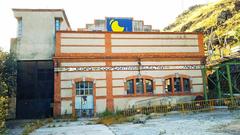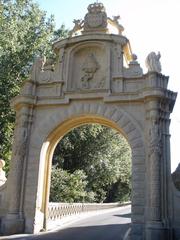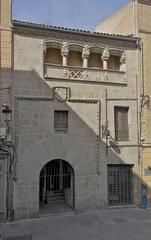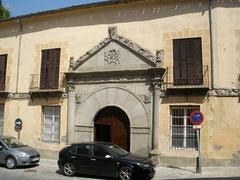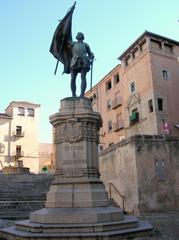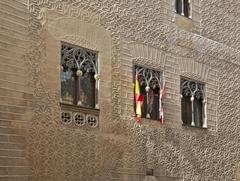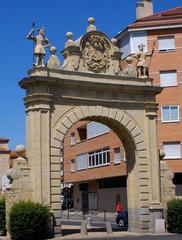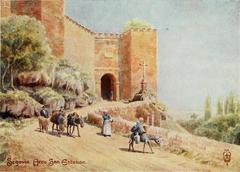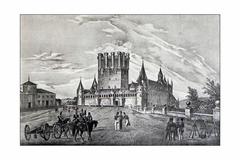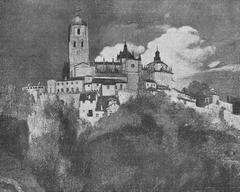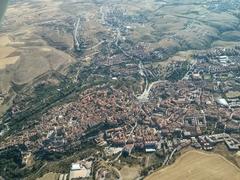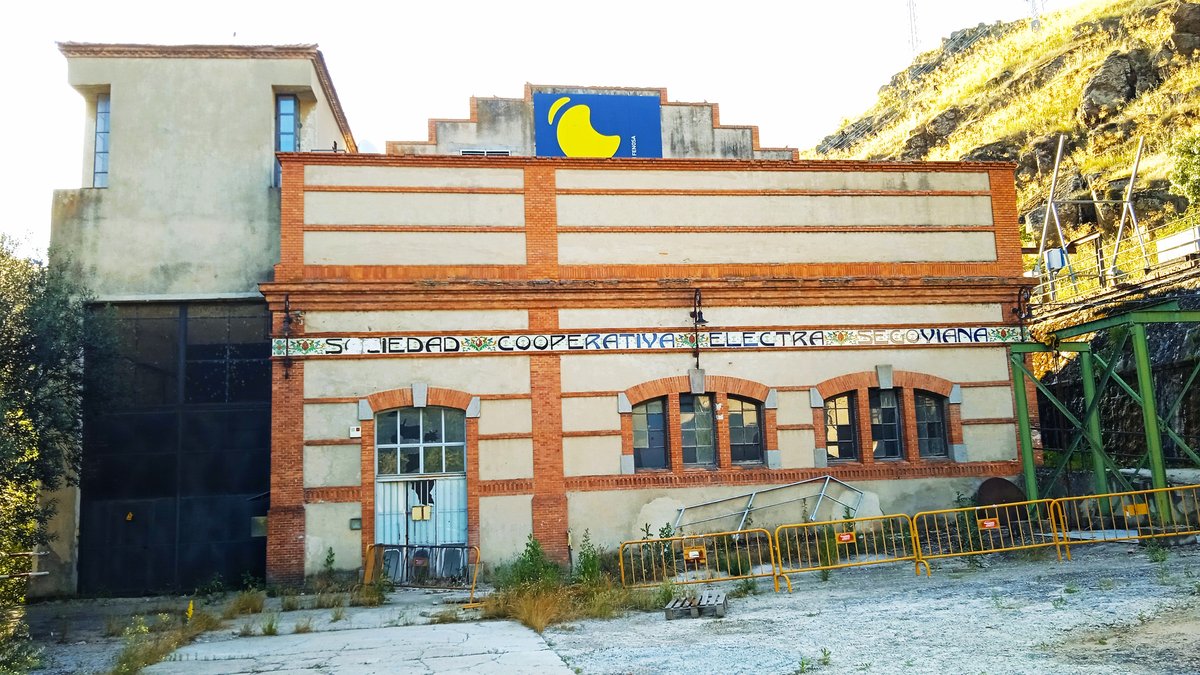
Sociedad Cooperativa Electra Segoviana: Visiting Hours, Tickets, and Travel Guide
Date: 14/06/2025
Introduction
Nestled in the heart of Segovia, Spain, the Sociedad Cooperativa Electra Segoviana is a cornerstone of the city’s industrial and social heritage. Founded in 1914 during an era of dynamic change, this cooperative played a pivotal role in electrifying Segovia, fostering economic growth, and raising living standards for its residents. Unlike traditional private utilities, Electra Segoviana adopted a cooperative model based on democratic governance and shared ownership—empowering local communities and ensuring equitable access to electricity, especially in underserved rural areas.
The cooperative’s architecture is a remarkable example of early 20th-century industrial design, with robust brick façades, arched windows, and ironwork that harmonize with Segovia’s historic urban landscape. Located near the Eresma River, it utilized hydroelectric power, showcasing a blend of technological progress and regional heritage preservation. Today, the site is a testament to community-driven innovation and sustainable development, offering visitors a unique window into Spain’s cooperative movement and Segovia’s journey toward modernization (Sociedad Cooperativa Electra Segoviana Official Website; Segovia Tourism Official Site; Segovia Wikipedia).
This guide provides a comprehensive overview for travelers: from historical context and architectural features to practical information such as tickets, accessibility, and nearby attractions. Whether you’re a history buff, architecture lover, or sustainability enthusiast, Electra Segoviana is an essential stop in Segovia.
Table of Contents
- Historical Background and Technological Innovations
- Visiting Sociedad Cooperativa Electra Segoviana: Practical Information
- Architectural Heritage and Cultural Significance
- Visitor Information and Recommendations
- Frequently Asked Questions (FAQ)
- Summary and Visit Tips
- Sources and Further Reading
Historical Background and Technological Innovations
Origins and Early Development
Founded at the beginning of the 20th century, Electra Segoviana emerged as a response to Segovia’s growing need for reliable and affordable electricity. Its cooperative structure—one member, one vote—ensured democratic governance and local investment. This model was especially impactful in rural areas, fostering resilience, collective ownership, and economic self-reliance (unaventanadesdemadrid.com).
Role in Regional Electrification
Electra Segoviana financed and built small-scale hydroelectric and thermal power plants, accelerating electrification across Segovia’s urban and rural communities. By 1922, it served over 2,000 clients, substantially improving access to modern energy and enabling new economic activities (eladelantado.com).
Socio-Economic Impact
The cooperative enhanced public health, education, and industrial productivity. It provided power to key local industries, such as the La Segoviana earthenware factory, and improved amenities like lighting for schools and healthcare centers. Its democratic structure promoted social cohesion and economic empowerment, leaving a legacy that endures today (scimatic.org).
Technological Progress and Sustainability
From early hydroelectric plants to modern energy innovations, Electra Segoviana has prioritized technological advancement and sustainability. The cooperative integrates renewable energy sources and supports community-centric solutions such as microgrids and electric vehicle infrastructure—aligning with Spain’s decarbonization goals and the EU Green Deal.
Integration with Regional Heritage
Electra Segoviana’s infrastructure supports the preservation and enhancement of Segovia’s UNESCO World Heritage sites, providing reliable lighting and climate control for landmarks like the Roman Aqueduct and Alcázar (World Heritage Site).
Visiting Sociedad Cooperativa Electra Segoviana: Practical Information
Location and Nearby Attractions
- Address: Central Segovia, Castile and León, Spain (exact address available at the local tourism office)
- Nearby Landmarks: Roman Aqueduct, Alcázar, Cathedral, La Segoviana earthenware factory
Visiting Hours and Tickets
- Interior Access: The original Electra Segoviana building is not open for regular public tours; visitors may view the exterior and its historical features from the street.
- Guided Tours: The cooperative’s history is included in Segovia’s industrial heritage walking tours, available via local tourism offices, especially during cultural festivals and special heritage events (turismodesegovia.com).
- Admission: No ticket is required to view the exterior. Fees may apply to special tours or events.
- Hours: Accessible for exterior viewing at any time; confirm tour schedules with the Segovia Tourist Information Office.
Accessibility
- The site is in Segovia’s historic center, accessible by foot from major attractions.
- Wheelchair access is available on most public routes, but cobblestone streets may present challenges.
- Parking is available at Parking Acueducto and Parking José Zorrilla; Segovia is easily reached via AVE trains from Madrid (Nomads Travel Guide).
Visitor Tips
- Combine Visits: Pair your exploration of Electra Segoviana with visits to the Roman Aqueduct, Alcázar, and the Royal Mint Museum.
- Photography: Capture the industrial and Art Deco architecture, especially on Calle Serafín and Calle del Socorro (Cultura Diversa).
- Events: Visit during major festivals like the Hay Festival or Semana de Cocina Segoviana for enhanced experiences (ViaSegovia).
- Audio Guides: Use the Audiala App for interactive, multi-language self-guided tours.
- Local Cuisine: Try Segovia’s signature dish, cochinillo, at nearby restaurants (Go Ask a Local).
Architectural Heritage and Cultural Significance
Industrial Heritage and Design
Electra Segoviana’s architecture is a prime example of early 20th-century industrial style, blending local stone and brick with steel trusses and large arched windows. Its utilitarian elegance reflects the functionalist ethos of the era and harmonizes with Segovia’s Romanesque, Gothic, and Renaissance environment (Segovia Wikipedia).
Urban Integration and Adaptive Reuse
Strategically situated to leverage the Eresma River’s hydraulic power, the cooperative’s facilities connect with other industrial landmarks, such as the Royal Mint (Casa de la Moneda). While the building’s design is modest compared to monumental sites, it complements Segovia’s diverse architectural heritage. Restoration initiatives have preserved original materials while adapting spaces for exhibitions and community events (Go Ask a Local).
Cultural and Educational Role
Electra Segoviana remains integral to Segovia’s cultural life, hosting events, workshops, and collaborations with local museums. It serves as an educational resource on the history of electrification, industrialization, and cooperative enterprise, with archives and interpretive displays accessible via local heritage institutions.
Visitor Information and Recommendations
- Guided Tours: Check with the Segovia Tourist Office for industrial heritage routes and specialized tours.
- Accessibility: Wear comfortable shoes for cobblestone streets; facilities cater to most mobility needs.
- Language: Spanish is primary, but English support is widely available in tourist areas.
- Amenities: Cafés, restaurants, and hotels abound in the historic district.
- Best Times to Visit: Spring and autumn offer pleasant weather and coincide with cultural festivals.
- Further Exploration: Visit the Real Casa de Moneda, Museo de Segovia, and Art Nouveau/Art Deco buildings for a comprehensive heritage experience.
Frequently Asked Questions (FAQ)
Q: Can I tour the interior of Sociedad Cooperativa Electra Segoviana?
A: The building is not open for interior visits; exterior viewing is possible, and its history is featured in local heritage tours.
Q: Are there guided tours focusing on Segovia’s industrial history?
A: Yes, local tourism offices offer tours including industrial sites like Electra Segoviana, especially during festivals or by appointment.
Q: What are the main attractions near Electra Segoviana?
A: The Roman Aqueduct, Alcázar, Cathedral, and Royal Mint Museum are all nearby and easily accessible.
Q: Is the site accessible for visitors with mobility challenges?
A: The area is generally accessible, but Segovia’s historic streets may be uneven.
Q: How do I get to Segovia from Madrid?
A: High-speed AVE trains connect Madrid to Segovia-Guiomar station, followed by a short taxi or bus ride to the city center.
Summary and Visit Tips
The Sociedad Cooperativa Electra Segoviana exemplifies the spirit of community empowerment, innovation, and sustainable development within Segovia’s historic landscape. While interior tours are not available, the site and its story offer invaluable insights into the city’s industrial and social transformation. Combine your visit with Segovia’s iconic landmarks for a comprehensive cultural experience, and enhance your exploration with digital guides and local events. For the most up-to-date visitor information, consult the official tourism websites and consider using the Audiala app for interactive tours (Segovia Tourism Official Site; Sociedad Cooperativa Electra Segoviana Official Website; Audiala App).
Sources and Further Reading
- Sociedad Cooperativa Electra Segoviana Official Website
- Segovia Tourism Official Site
- Segovia Wikipedia
- World Heritage Site - Roman Aqueduct
- Audiala App
- Go Ask a Local - Segovia Travel Guide
- Unaventanadesdemadrid.com
- Eladelantado.com
- Scimatic.org
- The Tour Guy - How to See Segovia in a Day
- Nomads Travel Guide - Self-Guided Walking Tour of Segovia
- Cultura Diversa - Segovia Art Deco and Art Nouveau
- ViaSegovia - Festivals and Cultural Activities
